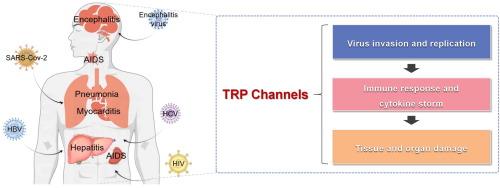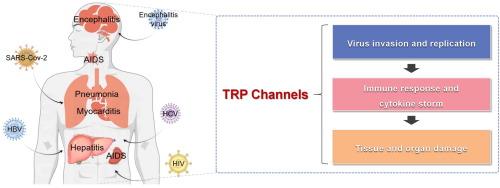病毒性传染病中的瞬时受体电位通道:生物学特征和调控机制。
IF 13
1区 综合性期刊
Q1 MULTIDISCIPLINARY SCIENCES
引用次数: 0
摘要
背景:长期以来,病毒性传染病一直是人类面临的挑战。近几十年来,瞬时受体电位(TRP)通道成为新研究的阳离子通道。越来越多的证据表明,TRP 通道介导的 Ca2+ 稳态紊乱以及相关的病理变化是病毒性传染病发生和发展的关键因素。然而,TRP 通道在这些疾病中的确切作用和机制仍有待系统阐明:综述的目的:本综述旨在系统地总结最近在了解病毒感染中的 TRP 通道方面取得的进展,并根据当前的进展和挑战,提出未来的研究方向:这篇综述总结了 TRP 家族的分类和生物学功能,探讨了 TRP 通道在病毒感染中的作用机制,并重点介绍了病毒、宿主和结果三个层面的具体机制。其中包括在病毒生物学和复制中的直接作用、在宿主免疫和炎症中的间接作用以及由此导致的病理变化。此外,我们还讨论了 TRP 家族在治疗病毒性传染病中的潜在应用,并提出了未来的研究方向。本文章由计算机程序翻译,如有差异,请以英文原文为准。


Transient receptor potential channels in viral infectious diseases: Biological characteristics and regulatory mechanisms
Background
Viral infectious diseases have long posed a challenge to humanity. In recent decades, transient receptor potential (TRP) channels have emerged as newly investigated cation channels. Increasing evidence suggests that TRP channel-mediated Ca2+ homeostasis disruptions, along with associated pathological changes, are critical factors in the onset and progression of viral infectious diseases. However, the precise roles and mechanisms of TRP channels in these diseases remain to be systematically elucidated.
Aim of Review
The aim of this review is to systematically summarize recent advances in understanding TRP channels in viral infections, and based on current progress and challenges, propose future directions for research.
Key Scientific Concepts of Review
This review summarizes the classification and biological functions of the TRP family, explores the mechanisms by which TRP channels contribute to viral infections, and highlights specific mechanisms at three levels: virus, host, and outcome. These include the direct role in viral biology and replication, the indirect role in host immunity and inflammation, and the resulting pathological changes. Additionally, we discuss the potential applications of the TRP family in the treatment of viral infectious diseases and propose future research directions.
求助全文
通过发布文献求助,成功后即可免费获取论文全文。
去求助
来源期刊

Journal of Advanced Research
Multidisciplinary-Multidisciplinary
CiteScore
21.60
自引率
0.90%
发文量
280
审稿时长
12 weeks
期刊介绍:
Journal of Advanced Research (J. Adv. Res.) is an applied/natural sciences, peer-reviewed journal that focuses on interdisciplinary research. The journal aims to contribute to applied research and knowledge worldwide through the publication of original and high-quality research articles in the fields of Medicine, Pharmaceutical Sciences, Dentistry, Physical Therapy, Veterinary Medicine, and Basic and Biological Sciences.
The following abstracting and indexing services cover the Journal of Advanced Research: PubMed/Medline, Essential Science Indicators, Web of Science, Scopus, PubMed Central, PubMed, Science Citation Index Expanded, Directory of Open Access Journals (DOAJ), and INSPEC.
 求助内容:
求助内容: 应助结果提醒方式:
应助结果提醒方式:


